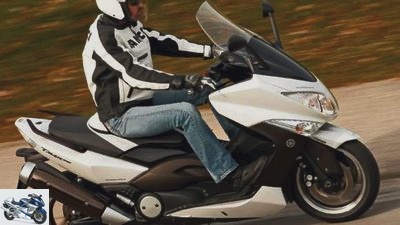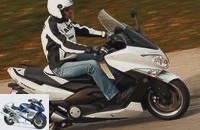Menus

Bilski
Test: Yamaha scooters
The Yamaha TMax White Max
No, it’s not the washing power that makes the TMax so economical. Rather, it’s the atypical scooter character that has been thrilling fans for ten years now.
Anno 2000, there was something. Right, the millennium. Contrary to expectations, the world did not end, on the contrary, with the Yamaha TMax a new category in the scooter segment was founded, that of the powerful two-cylinder scooter. In addition to the TMax, Gilera with the GP 800, Honda with the Silverwing and Suzuki with the Burgman 650 are plowing this field. Over the years, the TMax has been facelifted several times, but it has always remained true to the original concept.
Buy complete article

Test: Yamaha scooters
The Yamaha TMax White Max
TMax can only dream some motorcycles. Its 227 kilograms with a full tank prevent top marks in handling, rather the TMax gives the feeling of being full "heavy machine". Die-hard motorcyclists shouldn’t be fooled by the power-to-weight ratio. Despite 4.6 kilograms per horsepower, a motivated Maxchen must first be defeated on winding terrain. The standard ABS supports the brisk driving style in addition to the engine and chassis. Three discs, activated by adjustable hand levers, take care of vehement deceleration if necessary. The control range is noticeable in subtly pulsating levers.
Also unusual for motorcyclists are the full-face helmet plus small items holding compartment under the two-tone bench and the two unfortunately non-lockable compartments in the leg shield of the fairing. These are big enough for half-liter drinks bottles.
And what’s the catch? At 10,750 euros plus additional costs, it is the price that stands in the way of the TMax becoming more widespread. He has also had the attribute since its introduction ten years ago "loudest windshield in the world" with himself. At least if you are taller than 1.75 meters. Then only ear plugs or picking up a saw will help. But otherwise he’s already huge, the white one.
Technical specifications
Yamaha
The profile: fat front, slim bottom.
Engine:
Water-cooled two-cylinder four-stroke in-line engine, a balance shaft, two overhead, chain-driven camshafts, four valves per cylinder, bucket tappets, dry sump lubrication, injection, Ø 38 mm, regulated catalytic converter, 350 W alternator, 12 V / 9 Ah centrifugal clutch, stepless automatic belt , Chain, secondary ratio 2.262.
Bore x stroke 66.0 x 73.0 mm
Displacement 500 cc
Compression ratio 11: 1
rated capacity 32.0 kW (44 hp) at 7500 rpm
Max. Torque 46 Nm at 6500 rpm
Landing gear:
Steel tubular frame, telescopic fork, Ø 41 mm, drive unit swing arm, spring strut, double disc brake at the front, Ø 267 mm, double-piston floating caliper, disc brake at the rear, Ø 267 mm, single-piston floating caliper, ABS.
Cast aluminum wheels 3.50 x 15; 5.00 x 15
Tires 120/70 R 15; 160/60 R 15
Mass and weight:
Wheelbase 1575 mm, steering head angle 62.0 degrees, caster 95 mm, spring travel f / r 120/116 mm, seat height * 800 mm, 203 kg, weight with a full tank * 227 kg, payload 188 kg, tank capacity / reserve 15.0 / 3, 0 liters.
guarantee two years
colour White
price 10,750 euros
Additional costs 150 euros
Readings:
Driving performance (MOTORCYCLE measured values)
Top speed(Manufacturer information): 161 km / h
acceleration:
0-100 km / h 8.3 sec
0-140 km / h 17.9 sec
Draft:
60-100 km / h 4.3 sec
100-140 km / h 9.0 sec
Speedometer deviation effective (display 50/100) 48/95 km / h
consumption:
Country road 4.6 l / 100 km / h, normal
Theoretical range Country road 326 km
Related articles
-
Comparison test Kawasaki Ninja 250 R- Yamaha WR 250 X
Jahn 9 pictures Yamaha 1/9 Yamaha 2/9 Yamaha 3/9 Yamaha 4/9 Yamaha 5/9 Yamaha 6/9 Yamaha 7/9 Yamaha 8/9 Yamaha 9/9 Comparison test Kawasaki Ninja 250 R / …
-
Comparison test Aprilia Pegaso 660 Trail against BMW F 650 GS and Yamaha XT 660 R
Markus Jahn comparison test Aprilia Pegaso 660 Trail against BMW F 650 GS and Yamaha XT 660 R The story of the horse Aprilia had announced that the …
-
Jahn Test Yamaha Tmax 500 T-time It was time to renovate the Tmax 500 again. For the 2008 model year, Yamaha did it particularly thoroughly, but left the…
-
Comparison test: BMW K 1300 GT, Kawasaki 1400 GTR, Yamaha FJR 1300 A
Gargolov comparison test: BMW K 1300 GT, Kawasaki 1400 GTR, Yamaha FJR 1300 A Large tourers in Corsica In the tourer segment, there is hardly a path to the …
-
Comparison test BMW K 1200 GT, Honda Pan European, Yamaha FJR 1300 A
Gargolov comparison test BMW K 1200 GT, Honda Pan European, Yamaha FJR 1300 A Flying Dutchmen The opportunity has never been better: three express tourers …
-
Comparison test: Aprilia, BMW, Husqvarna, KTM and Yamaha
fact comparison test: Aprilia, BMW, Husqvarna, KTM and Yamaha single-cylinder fun bikes They have a big heart, a very big one. The new…
-
Yamaha X-Max 250 ABS in the test
fact 20 pictures fact 1/20 Yamaha X-Max 250 ABS in the compact test. fact 2/20 Yamaha X-Max 250 ABS in the compact test. fact 3/20 Yamaha X-Max 250 ABS in …
-
Yamaha TMax 530 and BMW C 650 Sport
Rossen Gargolov 24 pictures 1/24 Which large roller performs better? The Yamaha TMax 530 or the BMW C 650 Sport? …
-
Gargolov 10 pictures Rossen Gargolov 1/10 The D’elight is not a whirlwind. 7.3 HP is okay for the city. Rossen Gargolov 2/10 Rossen Gargolov …
-
Comparison test Honda CB 650 F, Yamaha TRX 850, Suzuki SV 650 S and Yamaha MT-07
fact 21 pictures fact 1/21 A huge boost to the parallel twin: the registered flat slide carburetor from Mikuni. fact 2/21 Despite the changed …